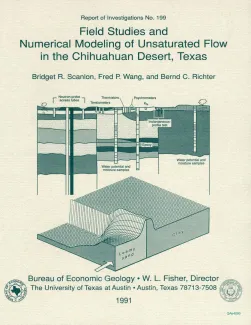
Publication Details
Geolocation:
Get the Publication
$11.50
Abstract/Description:
Field studies and numerical modeling were used to evaluate hydraulic controls on unsaturated flow in the Chihuahuan Desert of Texas. These studies were part of a program to characterize a site for a proposed low-level radioactive waste disposal facility. The study area was instrumented with neutron-probe access tubes to monitor moisture content and with thermocouple psychrometers to monitor water potential. The absence of temporal variations in moisture content monitored in deep (41 m) profiles indicated that water pulses are not moving through the system. Penetration of moisture after rainfall was restricted to the uppermost meter of the unsaturated zone because of the low degree of saturation of the surficial sediments. Water potentials were as low as -15.6 MPa near land surface. Except in the shallow subsurface after precipitation events, water potentials generally decreased upward; this trend indicated an upward driving force for liquid water movement, probably controlled by evapotranspiration.The computer code TRACRN was used to evaluate various unsaturated-flow processes in this system. One-dimensional simulation of infiltration was calibrated using 36CI data. Sensitivity analyses suggested that applied flux and initial water potential are the most critical factors in controlling the propagation of the wetting front. Analyses of potential leakage from the base of the proposed waste disposal facility indicated that the direction, as well as the net rate, of water movement is modified by lithologic layering in the system. Numerical modeling showed that a saturated zone will develop at the contact between the shallow coarse material and underlying clays when the downward leakage rates are similar to the saturated hydraulic conductivity of the deep clays.